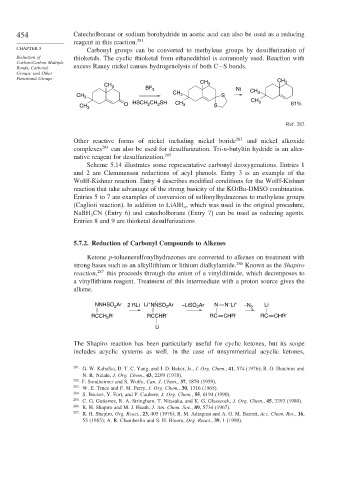Page 481 - Advanced Organic Chemistry Part B - Reactions & Synthesis
P. 481
454 Catecholborane or sodium borohydride in acetic acid can also be used as a reducing
reagent in this reaction. 281
CHAPTER 5 Carbonyl groups can be converted to methylene groups by desulfurization of
Reduction of thioketals. The cyclic thioketal from ethanedithiol is commonly used. Reaction with
Carbon-Carbon Multiple
Bonds, Carbonyl excess Raney nickel causes hydrogenolysis of both C−S bonds.
Groups, and Other
Functional Groups CH
CH 3 BF 3 CH 3 Ni 3
CH 3 CH 3 S CH 3
O HSCH CH SH CH 3 CH 3 81%
2
2
CH 3 S
Ref. 282
Other reactive forms of nickel including nickel boride 283 and nickel alkoxide
complexes 284 can also be used for desulfurization. Tri-n-butyltin hydride is an alter-
native reagent for desulfurization. 285
Scheme 5.14 illustrates some representative carbonyl deoxygenations. Entries 1
and 2 are Clemmensen reductions of acyl phenols. Entry 3 is an example of the
Wolff-Kishner reaction. Entry 4 describes modified conditions for the Wolff-Kishner
reaction that take advantage of the strong basicity of the KOtBu-DMSO combination.
Entries 5 to 7 are examples of conversion of sulfonylhydrazones to methylene groups
(Caglioti reaction). In addition to LiAlH , which was used in the original procedure,
4
NaBH CN (Entry 6) and catecholborane (Entry 7) can be used as reducing agents.
3
Entries 8 and 9 are thioketal desulfurizations.
5.7.2. Reduction of Carbonyl Compounds to Alkenes
Ketone p-toluenesulfonylhydrazones are converted to alkenes on treatment with
strong bases such as an alkyllithium or lithium dialkylamide. 286 Known as the Shapiro
reaction, 287 this proceeds through the anion of a vinyldiimide, which decomposes to
a vinyllithium reagent. Treatment of this intermediate with a proton source gives the
alkene.
–
+
–
NNHSO Ar 2 RLi Li + NNSO Ar –LiSO Ar N N Li –N 2 Li
2
2
2
RCCH R′ RCCHR′ RC CHR′ RC CHR′
2
Li
The Shapiro reaction has been particularly useful for cyclic ketones, but its scope
includes acyclic systems as well. In the case of unsymmetrical acyclic ketones,
281 G. W. Kabalka, D. T. C. Yang, and J. D. Baker, Jr., J. Org. Chem., 41, 574 (1976); R. O. Hutchins and
N. R. Natale, J. Org. Chem., 43, 2299 (1978).
282
F. Sondheimer and S. Wolfe, Can. J. Chem., 37, 1870 (1959).
283 W. E. Truce and F. M. Perry, J. Org. Chem., 30, 1316 (1965).
284
S. Becker, Y. Fort, and P. Caubere, J. Org. Chem., 55, 6194 (1990).
285 C. G. Gutierrez, R. A. Stringham, T. Nitasaka, and K. G. Glasscock, J. Org. Chem., 45, 3393 (1980).
286 R. H. Shapiro and M. J. Heath, J. Am. Chem. Soc., 89, 5734 (1967).
287
R. H. Shapiro, Org. React., 23, 405 (1976); R. M. Adington and A. G. M. Barrett, Acc. Chem. Res., 16,
53 (1983); A. R. Chamberlin and S. H. Bloom, Org. React., 39, 1 (1990).

